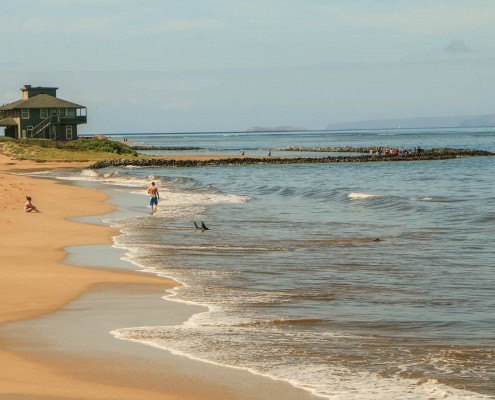
Maui’s World War 2 History
Maui’s Military Contribution To World War 2
The military history of Oʻahu during WW2 is well known. The attack on Pearl Harbor was the turn point for America’s entrance into the war on December 7th, 1941. What may not be well known is Maui’s military contributions to WW2. The island had the largest Naval Air Station in the world at the time in Puʻunēnē (central Maui) and throughout the war Maui was the training ground for tens of thousands of troops and pilots. It changed the entire society of that time by introducing a generation of new people to the island.
Pearl Harbor & World War 2 Influences
The Japanese attack on Pearl Harbor was a massive shock to the people of Maui. They fully expected an invasion and began to prepare by barricading beaches and building gun emplacements, the ruins of which can still be seen today. Several incidents only heightened the tension. A Japanese submarine lobbed shells into Kahului Harbor but luckily none of them exploded. Then on January 25th 1942 another submarine torpedoed and sank the transport ship General Royal T Frank in the channel between Maui and the Big Island. Twenty Nine persons were lost while 33 survived.
Maui quickly became a training ground for the war in the Pacific. There were two airfields built in Maui; Kahului which became today’s Maui Airport and Puʻunēnē in central Maui being home to the largest U.S. Naval Air Station of the war. Aircraft carriers would pause on their way to Oahu and all the planes would launch and fly to Maui’s air station for training while the carriers traveled on to Pearl Harbor empty of planes. Well over 20,000 pilots trained in the skies over Maui.
As you drive along Mokulele Highway between Kahului and Kihei you may notice out in the sugarcane fields some strange looking buildings. These are the remnants of the sprawling air station that included bomb and ammunition magazines, aircraft hangers, and staging areas for fighter, torpedo bomber and dive bombers and capacity for an entire aircraft carrier group. Today Maui Speedway, located between Kahului and Kihei, is one of the many runways in use at the naval air station during WWII.
Training for the War in the Pacific
By 1943 close to 50 different military training areas were in use as Maui became fully engaged in the war effort. The facilities included live grenade courses, pistol, rifle and machine gun ranges, a bazooka area, a mortar and artillery impact area, a seacoast artillery range, an anti-aircraft firing area, combat firing ranges for tanks and halftracks in coordination with infantry and a two story pier jutting into the ocean from the Kihei coastline. Amphibious training activities stretched from Ma’alaea Bay to Makena Landing.
When war broke out the population of Maui was around 47,000 people. By 1944 the number of military personnel on island was over 100,000. Though many units trained here the island was home to one particular unit, the 4th Marine division, also known as “Maui Marines”. This division of over 18,000 men lived and trained at “Camp Maui” along Kokomo road in Haʻikū. Today it is a beautiful community park with open fields, a playground and commemorative plaques. A hill overlooks the park and many of the marines who dated the locals girls would meeting with them in secret on this hill…hence it’s nickname “Giggle Hill”.
Maui Marines
The people of Maui loved their Marines who saw action in four pacific battlegrounds in 13 months (including Iwo Jima) and suffered an astonishing 75% casualty rate. When the Marines returned from Iwo Jima, their last battle, the island threw them a huge welcome home party at Kahului harbor. It is said that the so many Maui residents and service members showed up for this reception that the cheering could be heard 12 miles up the mountain at Camp Maui. Each marines was giving a pamphlet that read:
‘ ALOHA. Hi you Marines! Welcome home! It’s no “snow job” when we tell you that the service men and women and the civilians of Maui are throwing this big shindig for you because we think you’re just about the greatest guys that ever landed on this island. When the news came over the radio that the Marines had hit Iwo Jima, everybody asked the same question, “Are the Maui Marines there?” Then we heard the news flash that you and a lot of other Marines were in there pitching. After that, nothing else that happened seem to matter much. We don’t need to tell you that everyone from Hana to Lahaina is mighty proud of you. And when we read that you had named that first street “Maui Boulevard” we were practically bursting at the seams!
So welcome to Maui – the old friends and the new! Welcome to Iao Valley and Haleakala – to the rainbows and the rain (that everlasting rain at Camp Maui) – the steaks and the banana splits – the pineapple and the poi – the carnation lei and the steel guitars. But most important of all, welcome back to all the folks on Maui who think it might be a pretty good idea to add a new word to the famous slogan, MAUI NO KA OI and let the world know it is now, MAUI MARINES NO KA OI!’ It was signed “The People of Maui”.
Thousands of former G.I. settled on the island after the war. Of those who did not settle many returned as tourists which became the foundation of Maui’s modern economy.
Much damage was done to the Maui ecosystem during training in WWII. Kihei beaches where used for simulated beach assault training and underwater demolition training which forever changing the structure of this coastline. Many concrete bunkers were installed and can still be seen today as jumbled chunks of concrete which become visible as the waves uncover them on the beaches from time to time. Keep an eye out for these concrete ruins as you snorkel along the reef at Kamaole beaches I, II and III.
Other damages included the aerial bombing of Molokini Crater (it was approximately the size of an aircraft carrier) and the island of Kahoʻolawe which was used as target practice until the mid 1970’s. Much of it was cleaned up by the Navy and returned to the state but unexploded ordinance are still being found and disposed of to this day.
There is also the story of a ranch in Kula along the slopes of Haleakala. In 1942 Gordon and Mary Von Tempsky had a 5000 acre ranch that the family established in 1891. For some reason not known they invited Navy pilots up to their ranch. The pilots signed a wall within the home and amassed an estimated 20,000 autographs from the Navy pilots. The wall now resides at the National Aviation Museum in Pensacola Florida. It’s just another example of how Maui families showed their Aloha to our service members during the war.
Gordon “Boy” Von Tempsky also had an amazing collection of WW2 artifacts. The collection is now part of an exhibit and presentation to be shown at the Lahaina Library by Allen DeCoite on Dec 6th and 7th from 10am to 5pm.
So as you enjoy this island paradise keep in mind that it’s history and culture played a role in everything you see. It’s easy to learn about all the wonderful things to do in Maui while on vacation but also take the time to learn something about the culture. Please show respect for the sacrifices that were made here not only during WWII but also in ancient times.
Aloha Nui Loa
*From the book “Maui: A History” by Cummins E Speakman 1978 Updated in 1984, 2001 and 2014








